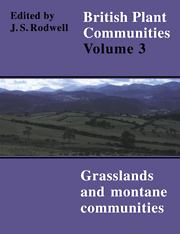Book contents
- Frontmatter
- Contents
- List of Figures
- Preface and Acknowledgements
- Preamble
- Mesotrophic Grasslands
- Community Descriptions
- Calcicolous Grasslands
- Community Descriptions
- Calcifugous Grasslands and Montane Communities
- Community Descriptions
- Index of Synonyms to Grasslands and Montane Communities
- Index of Species in Grasslands and Montane Communities
- Bibliography
U12 - Salix Herbacea-Racomitrium Heterostichum Snow-Bed
Published online by Cambridge University Press: 04 July 2020
- Frontmatter
- Contents
- List of Figures
- Preface and Acknowledgements
- Preamble
- Mesotrophic Grasslands
- Community Descriptions
- Calcicolous Grasslands
- Community Descriptions
- Calcifugous Grasslands and Montane Communities
- Community Descriptions
- Index of Synonyms to Grasslands and Montane Communities
- Index of Species in Grasslands and Montane Communities
- Bibliography
Summary
Synonymy
Salicetum herbaceae (Rübel 1912) Watson 1925; Salix herbacea nodum Poore 1955c p.p.; Salix + hepatic crust Ingram 1958; Rhacomitreto-Dicranetum starkei McVean & Ratcliffe 1962; Gymnomitreto-Salicetum herbaceae McVean & Ratcliffe 1962.
Constant species
Salix herbacea, Racomitrium heterostichum.
Rare species
Luzula arcuata, Minuartia sedoides, Sibbaldia procumbens, Kiaeria starkei, Gymnomitrion corallioides, Cetraria delisei, Solorina crocea.
Physiognomy
The Salix herbacea-Racomitrium heterostichum community includes a variety of carpets and crusts of bryophytes in which Salix herbacea is a constant feature. This tiny willow, rarely more than a couple of centimetres tall here, is sometimes quite abundant as a loose mat of prostrate shoots, their leaves and catkins appearing together in June as the last of the snow melts, or as late as August in the highest stands (Meikle 1984). In other cases, the cover of S. herbacea is patchy or generally sparse, when it is usually bryophytes which dominate, most commonly mixtures of Racomitrium heterostichum with one or other of R. fasciculare, Gymnomitrion concinnatum or the rare Kiaeria starkei, a moss that is locally abundant here, though not so consistently important as in the Polytrichum-Kiaeria community. R. lanuginosum, Conostomum tetragonum, Oligotrichum hercynicum and Polytrichum alpinum also occur frequently, though not usually with high cover, but P. sexangulare is only occasional. In some stands which are best included with this vegetation, the rare Marsupella brevissima ( = Gymnomitrion varians) is strongly dominant, crowding out many of the associates, and another related rarity G. corallioides occurs in this community in some places.
Other bryophytes recorded here include Pohlia nutans, Nardia scalaris and Barbilophoziafloerkii, which are quite frequent, and Diplophyllum albicans, Polytrichum piliferum and Lophozia sudetica, which are more occasional. Lichens are typically of sparse cover, but Cladonia bellidiflora, C. uncialis, C. pyxidata and Cetraria islandica are fairly common and the community provides one locus for the rare C. delisei and Solorina crocea.
Apart from S. herbacea, only Carex bigelowii and Deschampsia flexuosa occur frequently throughout this kind of vegetation and these are not generally more than moderately abundant. D. cespitosa, Omalotheca supina and Huperzia selago are occasionally found and there is sometimes a little Festuca ovinalvivipara, Luzula spicata, Juncus trifidus and Alchemilla alpina. Arctic-Alpine rarities that can find a place here include Luzula arcuata, Sibbaldia procumbens and Minuartia sedoides.
- Type
- Chapter
- Information
- British Plant Communities , pp. 424 - 429Publisher: Cambridge University PressPrint publication year: 1992

